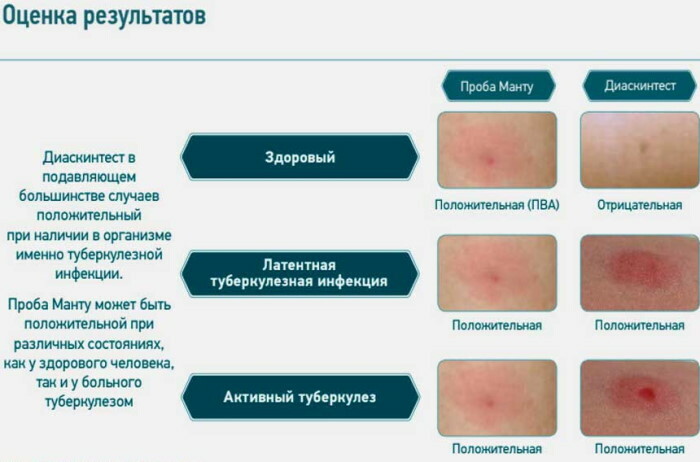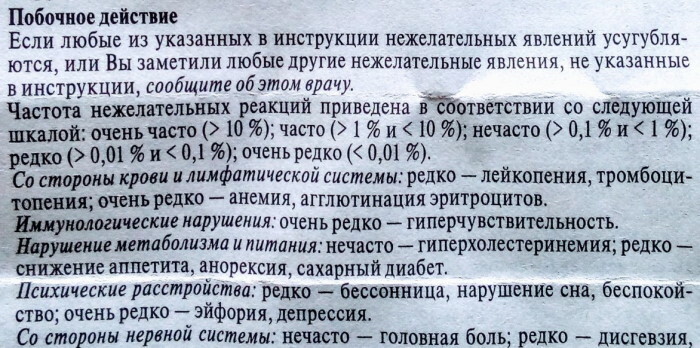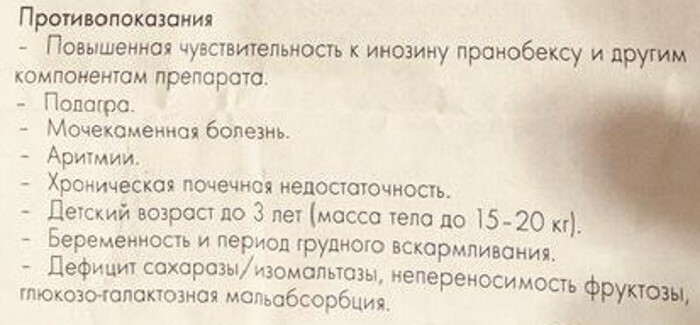Content
- Types of hemorrhages in the eye and differences in the drugs used
- Hyphema
- Hyposhagmus
- Droplet instillation rules
- List of the best drops for bleeding in the eye
- Emoxipin
- Taufon
- Vixipin
- Albucid
- Potassium Iodide
- Diclofenac
- Dephyslez
- Emoxy Optician
- Vitamin drops to strengthen the blood vessels of the eyes
- Recommended drops for the treatment of hemorrhages for certain categories of patients
- With oncology
- With pathologies of the iris of the eye
- With inflammation of the ocular blood vessels
- With hypertension
- With atherosclerosis
- With diabetes
- Comparison table of the effectiveness and prices of drugs
- Video about the treatment of intraocular hemorrhage
To eye drops that used for bleeding in the eye, the following requirements are imposed: they must quickly resolve hemorrhages and have a high safety profile. At the same time, when choosing drops, they are guided by the cause of the bleeding.
Types of hemorrhages in the eye and differences in the drugs used
Blood leaves the bloodstream when the integrity of the vessels and capillaries that feed the eye is disrupted. The severity of the process also depends on the localization of bleeding, which determines the tactics of treatment and the choice of drugs.
Hyphema
A condition in which blood accumulates in the anterior chamber of the eye - between the cornea and the iris - is called a hyphema. The most common cause of hyphema is trauma to the eyeball. In rare cases, this condition is caused by inflammation of the iris and ciliary body - iridocyclitis. The person feels pain in the eye, photophobia; vision is reduced.
The external picture is determined by the amount of blood poured out. With large injuries, the entire anterior chamber fills with blood: the entire eye looks crimson-red, its physical structures (iris, pupil, sclera) are indistinguishable. With relatively small vascular lesions, the blood clot is located in the lower part of the chamber, forming a horizontal level.
Hyphema is a dangerous condition and requires an appointment with an ophthalmologist. A blood clot or inflammatory exudate can block the pupil or drainage system of the eye - in this case, intraocular pressure rises. At the same time, with a decrease in the production of intraocular fluid and inflammation of the ciliary body, the pressure in the eye drops dramatically. Another possible complication is blood soaking in the cornea.
Treatment is aimed at reducing pain and inflammation. It is necessary to prevent an increase in intraocular pressure and re-bleeding, which in a third of cases develops within 3-5 days.
In combination with general therapy, mydriatics are used - pupil dilating drops (for example, atropine 1%). They reduce pain and photophobia. To combat inflammation, corticosteroids are considered the standard of treatment: 1% prednisolone eye drops are used. With iridocyclitis, antibiotics are prescribed. If it is necessary to lower the pressure, they resort to a combination of drops "Dorzolamid", "Timolol" and to ophthalmic solutions with brimonidine. The therapy is supplemented with vaso-strengthening and absorbable drugs.
Hyposhagmus
The blood clot is localized in the conjunctiva - the mucous membrane of the eye, or under it. Since the conjunctiva is literally laced with many small, fragile vessels and capillaries, they are easily damaged by severe coughing, sneezing, or heavy lifting. The reason for the rupture of the vascular walls may be an increase in blood pressure or blood-thinning therapy (taking aspirin, warfarin).
Another name for this condition is subconjunctival hemorrhage. No specific treatment is required unless there is a concomitant infection and the eye has not been injured.
With hyposhagmus, the conjunctiva is transparent, and the hemorrhage at first looks like a bright red spot against the background of the white sclera. As the resorption proceeds, the hemorrhages acquire a green, then yellow color. It takes up to 4 weeks to completely dissolve a significant hyposhagmus.
Eye drops for bleeding in the eye are used to facilitate the resorption of the bruise. If the hemorrhage is accompanied by dry eye syndrome, artificial tear preparations are used up to 4-6 times a day.
The condition should not be confused with redness of the eye with conjunctivitis. For infectious and inflammatory diseases of the eyes, other symptoms are characteristic: pain, lacrimation, pain, sensation of a foreign body in the eye. Pain sensations with hyposhagmus are insignificant or completely absent. As a rule, a person learns that a vessel has “burst” in his eye only by looking at himself in the mirror.
Droplet instillation rules
The main requirement for the safe application of drops is hygiene. It is important not only to keep your hands clean, but also not to touch the tip of the pipette or dropper cap to the mucous membrane of the eye.
The procedure is carried out as follows:
- Tilt your head back slightly and look up, while pulling the lower eyelid of the sore eye with the index finger of your free hand.
- Release a drop of solution into the resulting pocket, trying to drip closer to the outer corner of the eye.
- Release the eyelid and immediately press the inner corner of the eye with your fingertip to prevent fluid from leaking out or entering the sinuses.
- Close the eyelids so that the drug is evenly distributed over the surface of the eye. Then blink several times.
Important: the shelf life of most drops after opening the bottle decreases. Usually it is 30 days, but specific instructions should be found in the instructions for the drug.
List of the best drops for bleeding in the eye
One way or another, affecting the hemorrhage, the drops can have different directions. Angioprotectors have a direct effect: by strengthening the walls of blood vessels, they will reduce the risk of hemorrhages in diseases accompanied by their fragility. For the processes of healing and restoration of eye tissues, agents that improve metabolic processes (metabolism) are important. If the cause of the "red" eye is an inflammatory or infectious process, appropriate medications are needed.
Emoxipin
The drug has an angioprotective effect. The active substance is methylethylpyridinol. The substance reduces capillary permeability, strengthens blood vessels. The release of the liquid part of the blood from the vascular bed into the surrounding tissues decreases, which removes inflammatory edema.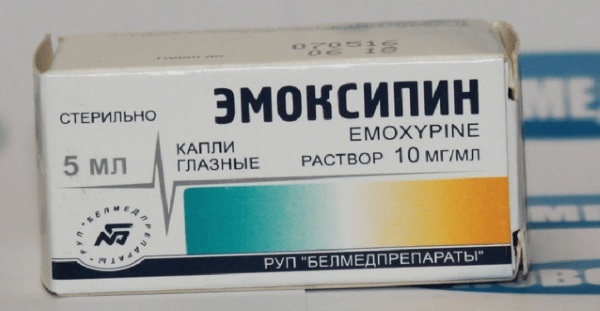
In addition, the agent inhibits platelet adhesion and reduces blood viscosity. As a result, capillary blood flow improves, and due to this, the nutrition of the eye tissues and their supply with oxygen are normalized. Emoxipin has an antioxidant effect, suppressing the oxidation of free radicals in cell membranes, which improves their resistance.
Eye drops are prescribed for hemorrhage in the eye for resorption of hemorrhages in the sclera and anterior chamber of the eye; for the treatment and prevention of retinopathy and thrombosis of the central retinal vein. The tool helps to restore the cornea in case of burns, inflammation, injuries.
Contraindications: intolerance to the components, pregnancy and lactation. Emoxipin is not used in pediatrics.
Application scheme: 1 drop 2 to 3 times a day. The duration of the course is determined by the characteristics of the disease and can range from 3 to 30 days. If several types of drops are prescribed, Emoxipin should be instilled last, after waiting 15 minutes after the introduction of the previous drugs. The product may cause a burning sensation in the eyes, which passes quickly. Among the auxiliary components is sodium sulfite, which sometimes causes severe allergic reactions.
Taufon
The drops contain the amino acid taurine, which is found in large quantities in the refractive media of the eyeball. Taufon improves metabolism, helping to restore retinal tissue, cornea and lens with age-related changes. The drug is prescribed in the early stages of cataract, to restore the cornea after trauma and as part of therapy for glaucoma. With a tendency to hemorrhage, Taufon is used as an additional remedy.
There are few contraindications: allergy to the components of the drug and age up to 18 years. The agent is instilled in 1-2 drops 2-4 times a day for 3 months for cataracts, 6 weeks for glaucoma and 1 month for corneal injuries. If necessary, after a break, the course can be repeated.
Vixipin
The drug is an analogue of Emoxipin. It has an antioxidant effect in the same way; improves the supply of oxygen to tissues; strengthens vascular walls and improves microcirculation.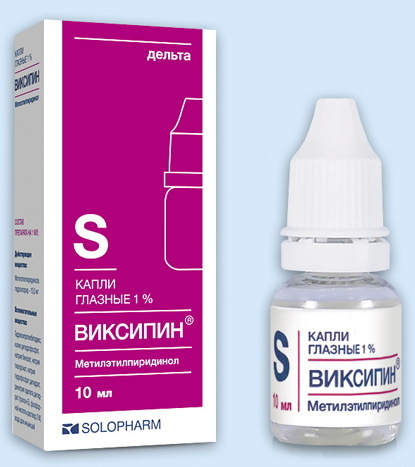
Drops are prescribed in the same situations as Emoxipin. The scheme of use and contraindications are the same. There are differences in the composition of excipients. So, in Vixipin there is no allergenic component sodium sulfate. In addition to standard 5 ml vials, Vixipin is available in 0.5 ml dropper vials. Small package is convenient for resorption of hemorrhages when long-term treatment is not required.
Albucid
Antimicrobial drops based on sulfacetamide. Another name for the drug is sodium sulfacil. Like all sulfa drugs, Albucid inhibits the growth and reproduction of microbes, being active against the most common representatives of the coccal flora, including the bacteria Chlamydia trachomatis - a frequent pathogen conjunctivitis. Albucid is prescribed for the treatment of inflammatory and infectious diseases of the eyelids and internal tissues of the eye. It serves as an additional tool in eliminating hemorrhages if the inflammatory process is the cause.
Sulfacetamide remains in the tissues of the eye for 3 hours after the application of the drug. To maintain its constant concentration, the agent is instilled every 2-3 hours. As the condition improves, the number of installations is reduced. The required course of treatment is 7-10 days. Drops can cause burning and stinging when instilled. The drug is contraindicated in infants up to 2 months and with individual drug intolerance.
Potassium Iodide
A 3% solution of potassium iodide in the form of drops is used as an "absorbable" agent for hemorrhages in the eyeball. Other recommendations for use are: opacity of the vitreous body and cornea, cataract. Within 10-15 days, 2 drops are instilled 3-4 times a day. The drug is contraindicated in hypersensitivity to iodine, hyperthyroidism, pregnancy and pyoderma. In Russia, the ophthalmic form of the drug is produced only in the prescription-production departments of pharmacies. There is no factory production of drops.
Diclofenac
Eye drops based on diclofenac sodium - a non-steroidal (that is, non-hormonal) anti-inflammatory agent. They are prescribed for purulent conjunctivitis of non-infectious origin. The tool is used to prevent inflammatory complications after eye injuries or ophthalmic operations.
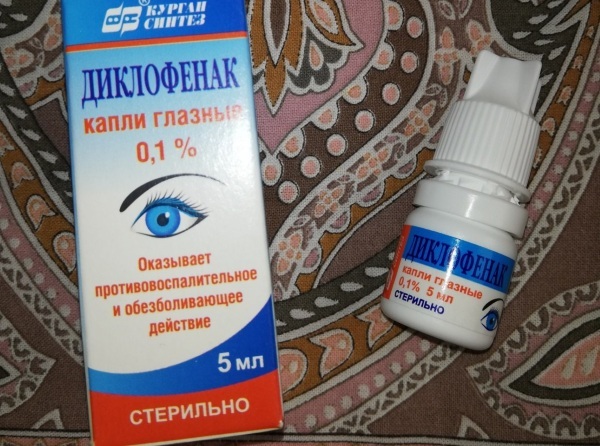
The drug reduces pain and inflammatory edema, which can cause increased fragility of the eye vessels and hemorrhages. Duration of treatment: 1-2 weeks. Instillation mode: 1 drop 3-4 times a day. Contraindications: last trimester of pregnancy, NSAID intolerance. Drops are used in pediatrics, starting from 2 years of age.
Dephyslez
The active ingredient is hypromellose, which acts as a substitute for natural tears. The drops moisturize the eye and preserve the tear film, which protects the outer layer of the cornea from external factors. The drug is used to eliminate the symptoms of "dry eye": reddened proteins, itching, feeling of "sand" under the eyelids. Drops contribute to the restoration of the corneal epithelium after keratoplasty, trauma, burns, ulcers and erosions.
Dephysliasis is prescribed for older people taking beta-blockers, pressure medications that reduce tear production and thin the tear film. The drug is contraindicated in pregnant and lactating women. In acute conditions, the drug is instilled 1 drop every hour. The usual frequency of the procedure is 4-8 times a day. The course of treatment is 3 weeks. After instillation, blurred vision is possible, which quickly passes.
Emoxy Optician
Another analogue of Emoxipin. The drug has the same combination of therapeutic effects necessary for the elimination and prevention of ocular hemorrhage. The scheme of application and conditions of administration are the same as with Emoxipin.
Vitamin drops to strengthen the blood vessels of the eyes
The following vitamins are important for the health of the vascular system of the eyeball:
- Vitamin A (retinol) and its precursor β-carotene. Retinoid forms of the vitamin are part of the main visual pigment, are components of cell membranes, and provide antioxidant protection of eye tissues. With a lack of vitamin, night vision worsens, the production of tear fluid is impaired.
- B vitamins - necessary participants in cellular metabolism; participate in hematopoiesis. Thiamine deficiency (B1) leads to a decrease in visual acuity and the development of glaucoma; riboflavin (B2) - to frequent conjunctivitis. Cyanocobalamin (B12) improves blood flow and function of the optic nerves. Nicotinic acid (PP or B3) expands the lumen of blood vessels.
- Vitamin P (rutin) strengthens the walls of blood vessels and increases their elasticity.
These vitamins are available in oral vitamin complexes.
To strengthen blood vessels, including the retina, ascorbic acid, rutin and ascorutin are prescribed. They come in the form of tablets or pills.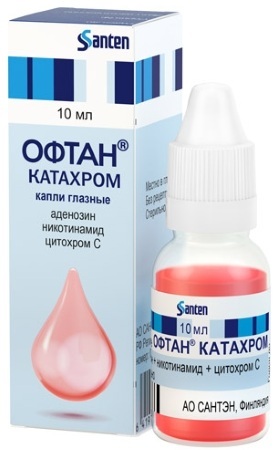
In the form of eye drops, there are the following vitamin preparations:
- Oftan Katahrom - contains three components that improve metabolic processes in the eye and have an antioxidant effect: vitamin B3, adenosine and cytochrome C. It has a positive effect on the state of the lens. Drop 1 drop 2-3 times a day.
- Vita-Iodurol - improves blood supply to the eye and tissue metabolism. Contains adenosine, calcium, magnesium and niacin.
- Vizox - drops for eye health, intended for oral administration after dilution in water. Contains a complex of herbal ingredients. Strengthens the retina, improves microcirculation, prevents age-related changes in tissues. It is taken in a monthly course, diluting 10 drops in 50 ml of water.
- Opti Vision - improves blood supply and tissue nutrition, moisturizes the mucous membrane, helps to maintain visual acuity. The drug contains a complex of components important for vision: A, C, B6, rutin, blueberry anthocyanins, lutein. Like Visox, drops are taken orally: 20 drops in a glass of water.
Recommended drops for the treatment of hemorrhages for certain categories of patients
Most often, a small vessel bursts in the eye as a result of a jump in blood pressure or during physical exertion - in this case, the effect of "absorbable" drops is most noticeable. However, the reason may be in a number of pathological processes that occur in the eyeball or in the body as a whole.
Changes in blood vessels in systemic diseases or inflammatory processes occurring in the internal environment of the eye lead to rupture of the vascular walls. The integrity of the vessels can be impaired due to compression by the tumor.
With oncology
The clinical picture of a tumor depends on the nature of the neoplasm and its location. Malignant growth is characterized by a combination of local disease processes (education swelling, inflammation) with symptoms of general intoxication: increased body temperature, increased lymph nodes. A far-advanced process can be manifested by exophthalmos (protrusion of the eyeball), double vision, strabismus.
A tumor growing in the tissues of the eyeball and orbit compresses the vessels, which damages their walls and provokes hemorrhages. The main principle of treatment: removal of the tumor using surgery or chemotherapy.
Eye drops for bleeding in the eye do not cure malignant neoplasms: in some cases, they can only partially help to cope with symptoms. This is provided that their use will be safe with one or another nature of the neoplasm. For example, the appointment of agents that accelerate cell metabolism is undesirable for malignant cell growth.
With pathologies of the iris of the eye
The iris is the well-supplied anterior choroid. In addition to traumatic and dystrophic lesions of the iris, its inflammatory disease, iritis, is often found. When the ciliary body is involved in the process, iridocyclitis develops. With the disease, severe pain is felt, the pupil is narrowed. The eye reacts painfully to light, sees poorly. The cause of the pathology can be a physical effect on the eye, viral infections or rheumatic diseases.
First of all, mydriatics are prescribed in the form of drops. When the pupil dilates, the vessels of the iris contract, which stops the release of exudate and paralyzes accommodation. The pupil remains stationary - this relieves pain. In addition, antibiotics, hormonal or non-steroidal anti-inflammatory drugs are used.
Recommended topical medications include:
- Atropine;
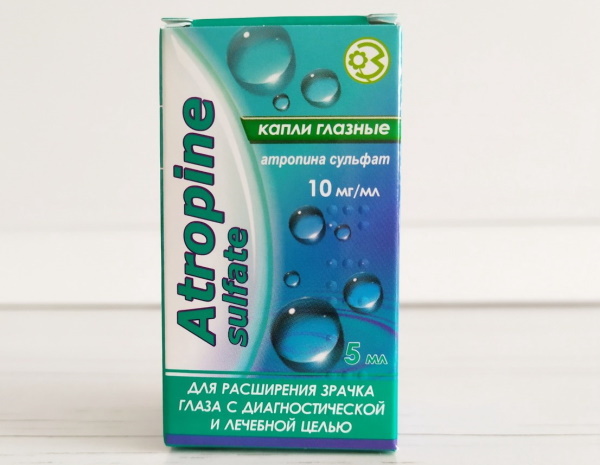
Atropine eye drops - Phenylephrine;
- Irifrin;
- Indocollyr (Indomethacin);
- Dexamethasone;
- Ciprofloxacin;
- Tobradex;
- Ophthalmoferon.
In addition to anti-inflammatory action, the glucocorticosteroid Descamethasone reduces redness of the eyes.
With atrophy of the iris, drops are prescribed that reduce intraocular pressure, as well as drugs that improve microcirculation and metabolic processes:
- Emoxipin;
- Vixipin.
With inflammation of the ocular blood vessels
In the blood supply system of the eye, the choroid is adjacent to the vessels of the retina. As a rule, inflammation develops in these two segments at once and is called chorioretinitis. The cause is an infection brought along with the blood flow from other parts of the body with toxoplasmosis, tuberculosis or cytomegalovirus.
Typical symptoms: blurred vision, intolerance to light, redness of the eyes. Inflammatory foci occur in the peripheral regions, and at first the disease does not affect visual acuity. With the course of the disease, the lesion spreads to the adjacent retinal membrane, passes to the macula - the central region of the retina. At this stage, the visual impairment is serious.
Anti-inflammatory, anti-infectious and vascular-strengthening drugs are used: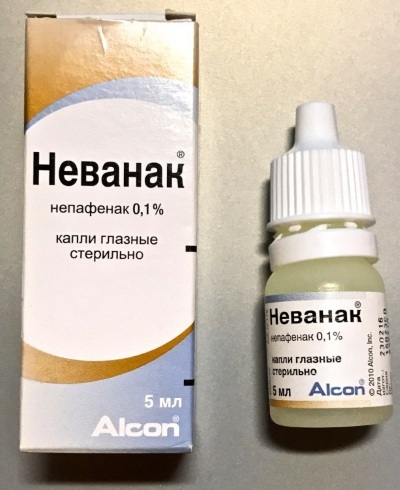
- Diclo-F (diclofenac);
- Nevanak (nepafenak);
- Indocollir;
- Potassium Iodide.
With hypertension
The pressure spike in hypertension can cause bleeding in the eye. From a ruptured vessel, blood spreads to the tissues of the eye. In this case, a cold compress or ice pack will help in the first hours.
To make the hemorrhage dissolve faster, apply:
- Potassium Iodide;
- Emoxipin;
- Vixipin;
- Emoxibel.
A general increase in blood pressure also leads to changes in the vessels of the eye. The defeat of the vessels of the retina is called hypertensive retinopathy. Small hemorrhages, exudate, edema are observed in the retina.
Over time, the area of damaged retinal vessels grows, which prevents photons from reaching nerve receptor cells: some of them are absorbed and reflected by blood vessels, without reaching the photosensitive retinal layer. Visual acuity decreases. For the prevention of retinal hemorrhages, drops are prescribed to strengthen the walls of blood vessels: the same Emoxipin and vitamin drops.
With atherosclerosis
The walls of the ocular arteries in atherosclerosis thicken and harden, which reduces blood flow to the tissues of the eye. As the vessels thicken, small retinal hemorrhages occur. There is a possibility of such serious complications as blockage of the central artery or retinal vein.
Excessive bleeding occurs when the central vein is blocked. As the hemorrhage resolves, vision improves. If the central artery or one of its main branches is blocked, vision is lost in whole or in part.
Eye drops for hemorrhage in the eye with atherosclerosis are used the same as in the treatment of hypertensive retinopathy:
- Emoxipin and its analogues;
- Potassium Iodide;
- vitamin drops with nicotinic acid.
With diabetes
With an increased level of glucose in the blood, the integrity of the vascular walls is disrupted. Diabetes mellitus is complicated by diabetic retinopathy. Its course is characterized by retinal hemorrhages, exudate, capillary thrombosis. The main threat to vision is the abnormal proliferation and formation of new vessels, which leads to retinal detachment and optic nerve atrophy. Another complication is diabetic cataract.
As part of complex therapy, the following are used:
- Emoxipin;
- Potassium Iodide;
- Taufon;

Taufon eye vitamins - vitamin drops with retinol and B vitamins.
Comparison table of the effectiveness and prices of drugs
Eye drops for bleeding in the eye are therapeutic. The most effective drugs are those that can directly and at the same time affect the problem in a complex way. In this sense, methylethylpyridinol-based drops have an advantage. Potassium Iodide drops also have a direct effect on hemorrhages. The rest of the drugs shown in the table reduce the likelihood of bleeding or promote healing.
| Name of the drug | Active substance | Action | Price |
| Emoxipin (RF) 5 ml | Methylethylpyridinol |
Complex impact:
|
RUB 195-300 |
| Vixipin (RYa) | RUB 300; 12 RUB (unidose) | ||
| Emoxy Optician (RF) | 171 r | ||
| Potassium Iodide (Ukraine) | Potassium iodide solution | Absorbent | RUB 400 |
| Diclofenac (RF, Romania) | Diclofenac sodium | Anti-inflammatory | RUB 25 - 67 |
| Defislez (RF) | Hypromellose | Protects the corneal epithelium | RUB 49 |
| Taufon (RF) | Taurine | Metabolic | 103 rbl. |
| Vita-Iodurol (France) | Calcium and magnesium chlorides, adenosine, nicotinic acid | 330 RUB |
The least dangerous are hemorrhages in the conjunctiva of the eye. Despite their frightening appearance, they do not lead to visual impairment and can safely dissolve in a few days and without the use of eye drops. However, in case of hemorrhage in the eye, it is important to find out whether the cause of the fragility of the vessels was a serious disease.
Video about the treatment of intraocular hemorrhage
Intraocular hemorrhage:

